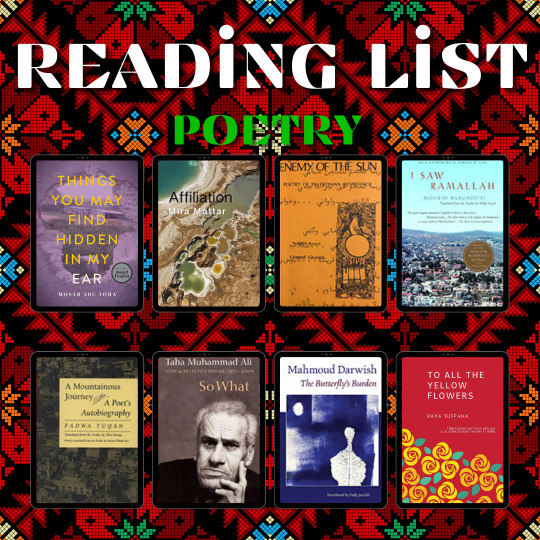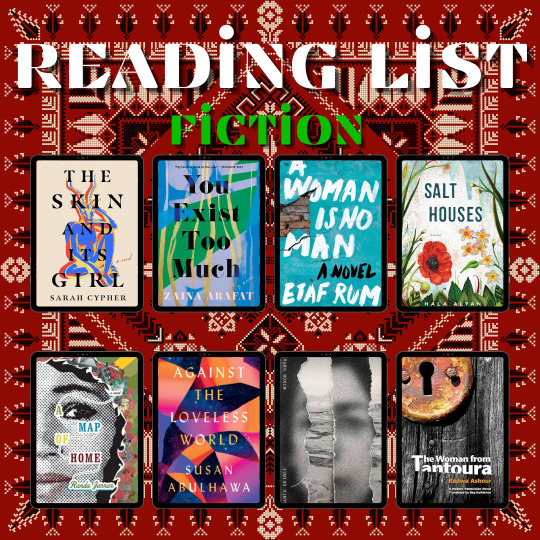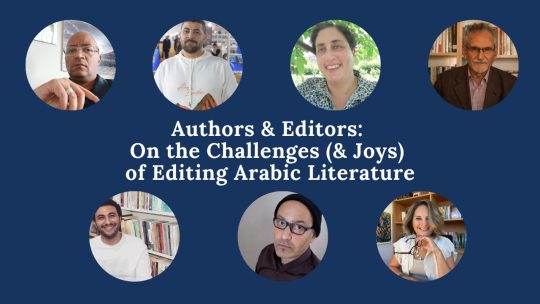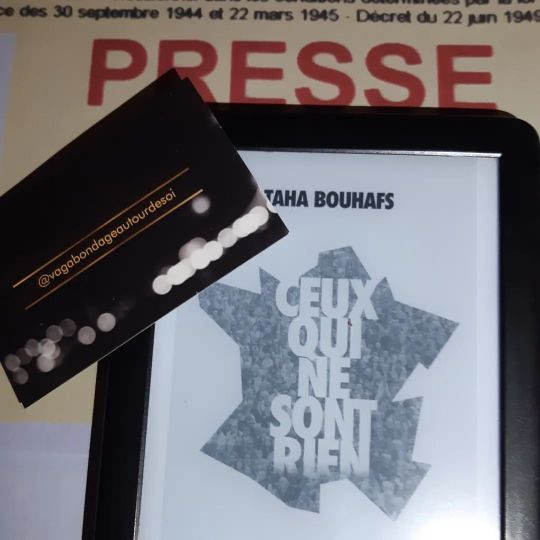#and Essayed Taha
Text
It's 4 am but anyway I'm glad I reached the point in my selfship journey? Time? Period? Era? Where I can just not really care to be insecure about it or try and desperately gain validation or attention for it and simply yap that's what I was meant to do .... Yap about my love
#I don't yap here I yap on twt#It's just quicker and the word limit keeps me leashed so I don't write essays LMAO#taha talks
13 notes
·
View notes
Text








Read Palestine Week
🇵🇸 Good morning, my beautiful bookish bats. Can I start by saying a huge THANK YOU for sharing my Queer Palestinian Book post? Seriously, thank you so much. Let's keep that momentum by observing Read Palestine Week (Nov 29 - Dec 5). I've compiled a list of books to help you, along with a list of upcoming events and resources you can use this week and beyond.
🇵🇸 A collective of over 350 global publishers and individuals issued a public statement expressing solidarity with the Palestinian people. Publishers for Palestine have organized an international #ReadPalestine week, starting today (International Day of Solidarity with the Palestinian People).
🇵🇸 These publishers have made many resources and e-books available for free (with more to come). A few include award-winning fiction and poetry by Palestinian and Palestinian diaspora authors. You'll also find non-fiction books about Palestinian history, politics, arts, culture, and “books about organizing, resistance, and solidarity for a Free Palestine.” You can visit publishersforpalestine.org to download some of the books they have available.
POETRY
🌙 Things You May Find Hidden in My Ear by Mosab Abu Toha
🌙 Affiliation by Mira Mattar
🌙 Enemy of the Sun by Samih al-Qasim
🌙 I Saw Ramallah by Mourid Barghouti
🌙 A Mountainous Journey by Fadwa Tuqan
🌙 So What by Taha Muhammad Ali
🌙 The Butterfly’s Burden by Mahmoud Darwish
🌙 To All the Yellow Flowers by Raya Tuffaha
FICTION
🌙 Gate of the Sun by Elias Khoury
🌙 Speak, Bird, Speak Again: Palestinian Arab Folktales
🌙 Men in the Sun by Ghassan Kanafani
🌙 Morning in Jenin by Susan Abulhawa
🌙 Gaze Writes Back by Young Writers in Gaze
🌙 Palestine +100:Stories from a Century after the Nakba
🌙 Wild Thorns by Sahar Khalifeh
🌙 Out of Time by Samira Azzam
🌙 The Skin and Its Girl by Sarah Cypher
🌙 You Exist Too Much by Zaina Arafat
🌙 A Woman is No Man by Etaf Rum
🌙 Salt Houses by Hala Alyan
🌙 A Map of Home by Randa Jarrar
🌙 Against the Loveless World by Susan Abulhawa
🌙 Minor Detail by Adania Shibli
🌙 The Woman From Tantoura by Radwa Ashour
NON-FICTION
🌙 Blood Brothers by Elias Chacour
🌙 Strangers in the House: Coming of Age in Occupied Palestine by Raja Shehadeh
🌙 Palestinian Art, 1850–2005 by Kamal Boullata
🌙 Palestine by Joe Sacco
🌙 The Hour of Sunlight: One Palestinian’s Journey from Prisoner to Peacemaker by Sami Al Jundi & Jen Marlowe
🌙 Palestine: A Four Thousand Year History by Nur Masalha
🌙 Justice for Some: Law and the Question of Palestine by Noura Erakat
🌙 The Words of My Father: Love and Pain in Palestine by Yousef Khalil Bashir
🌙 Traditional Palestinian Costume: Origins and Evolution by Hanan Karaman Munayyer
🌙 Mountain against the Sea: Essays on Palestinian Society and Culture by Salim Tamari
🌙 This Is Not a Border: Reportage and Reflection from the Palestine Festival of Literature
🌙 We Could Have Been Friends, My Father and I: A Palestinian Memoir, by Raja Shehadeh
🌙 Les échos de la mémoire. Une enfance palestinienne à Jérusalem, by Issa J. Boullata
🌙 A Party For Thaera: Palestinian Women Write Life In Prison
🌙 Light in Gaza: Writings Born of Fire,
🌙 Voices of the Nakba: A Living History of Palestine
#free palestine#save palestine#books#book list#book recs#book recommendation#booklr#book blog#batty about books#battyaboutbooks#arab american heritage month#arab american writers#palestinian writers#palestinian poetry#poetry#poetry books#nonfiction#fiction books#queer fiction#queer community#queer books#muslim writers#read palestine week
216 notes
·
View notes
Text
2024 (23)
fictions (jorge luis borges) - 10/10
a raisin in the sun (lorraine hansberry) - 9/10
memory for forgetfullness (mahmoud darwish) - 10/10
black friend: essays (ziwe) - 10/10
are prisons obsolete? (angela y. davis) - 10/10
waiting for godot (samuel beckett) - 10/10
the garden party (vaclav havel) - 9/10
dust tracks on a road (zora neale hurston) - 9/10
wild thorns (sahar khalifeh) - 10/10
everything good will come (sefi atta) - 10/10
men in the sun and other palestinian stories (ghassan kanafani) - 10/10
minutes of glory and other stories (ngugi wa thiong'o) - 10/10
midaq alley (naguib mahfouz) - 9/10
a man of letters (taha hussein) - 7/10
the beggar's opera (vaclav havel) - 8/10
soul gone home (langston hughes) - 8/10
mulatto (langston hughes) - 10/10
the weary blues (langston hughes) - 9/10
the quarter (naguib mahfouz) - 10/10
pedagogy of the oppressed (paulo freire) - 10/10
after midnight (irmgard keun) - 9/10
a gentleman in moscow (amor towles) - 7/10
peace and its discontents (edward said) - 10/10
0 notes
Text
Authors vs. Editors: A Dialogue on the Challenges And Beauties of Editing Arabic Literary Works
By Essayed Taha
In 2014, when the late Mourid Barghouti was chair of the panel of judges for the International Prize for Arabic Fiction, he used his awards-ceremony speech to read a manifesto about what he saw as wrong with the Arabic publishing landscape. He said, in his comments about publishers:
“But the most important thing is the absence of the literary editor. Publishers in our countries…

View On WordPress
#Ahmed Saied#Haytham El-Wardany#Mahmoud Shukair#Mostafa Eltelwany#Rana Hayeck#Samar Abou-Zeid#Yasser Abdellatif
1 note
·
View note
Text
HIS5067 - Lit Review/Discussion Prep #7
Heritage tourism reflects a complex history of commodification, public engagement, and economics. This week, we read articles that provide a global framework for the tensions, challenges, and opportunities associated with the restoration and economic revitalization of historic sites. Scholastic concerns range from the theoretical understanding of spectacle and simulation to the practical issue of funding and government vs. private interests. In the following post, I examine the scholarship of Britt Baillie, Afroditi Chatzoglou and Shadia Taha; Ruth McManus and Gerry O’Reilly; Gerald Figal and M. Christine Boyer.
The authors of the selected readings address and contextualize heritage tourism at three respective world sites: South Street Seaport in New York City, Fáilte Island in Ireland, and Okinawa, Japan. Notable to me is the fact that each of these sites are geographically located on islands, where distinction/isolation/containment lends well to the “world-building” narratives constructed around them. For example, in “Cities for Sale: Merchandising History at South Street Seaport,” M. Christine Boyer uses Manhattan’s historic South Street Seaport as a case study for the history of city tableaux, their role in public memory and consumption, and the private industries that fuel public ventures. Tableaux are divided into three main types: historic quarters, special districts, and residential enclaves (Boyer 1992, 187-88). Boyer argues that tableaux are “nonplaces” at the “margins of reality” that are designed for escape and gratification (Boyer 1992, 192). There is an element of spectacle and theatricality to the presentation of tableaux that transforms sites like the Seaport into simulations “carefully orchestrated to channel nostalgic desires” (Boyer 1992, 201). Tourists visit an aesthetic illusion meant to attract spending and consumption. Additionally, Boyer’s history of New York City’s planning and development raises important questions about the players involved in economic “staging” – principally who sets the stage and who occupies it.
In “Between War and Tropics: Heritage Tourism in Postwar Okinawa,” Gerald Figal centers the tensions highlighted by Boyer asking, “how have public and private tourism developers and promoters mined and negotiated Okinawa’s varied past and complicated future to produce a marketable Tourist Okinawa?” (Figal 2008, 84). For Okinawa, an island with a complex history of war and colonial occupation, the transformation and commodification of its past has resulted in marketable branding closely bound to local identity (Figal 2008, 107). It reflects another aspect of Boyer’s spectacle – “Tourist Okinawa” is a fantasy developed in response to the island’s relationship to mainland Japanese taste and an imperial-era sense of national duty.
As Figal’s essay highlights, nationalist tensions can play a significant role in the marketing of dark heritage or “traumascapes” (Baillie et al. 2012, 58). In “Heritage Tourism and the Commodification of Contested Spaces: Ireland and the Battle of the Boyne Site,” Ruth McManus and Gerry O’Reilly survey the shifting meaning and interpretation of the defining seventeenth century military battle closely associated with Irish identity. They argue that for “contested spaces, although commodification is sometimes negatively viewed as a way of ‘neutralizing’ the past, this may also be seen as a political and social necessity” (McManus and O’Reilly 2017, 54).
In “Packaging the Past: The Commodification of Heritage,” scholars Britt Baillie, Afroditi Chatzoglou and Shadia Taha assert that commodification offers both challenges and opportunities. For some publics, it drives market value which in turn supports local businesses and economies. To others, especially when commodification involves the restructuring of culturally significant sites, commodification can be criticized for sanitizing heritage to make it palatable to the aims of tourism. Baillie et al. are concerned with evaluating the concept through its change over time (Baillie et al. 2012, 51). They argue that authenticity is a compromise dependent on society’s shifting perception of value (Baillie et al. 2012, 66). As a result, we must move beyond the myth of heritage as priceless and commodification as a necessary evil (Baillie et al. 2012, 69). Only through this recognition can historians critically and constructively engage with the dynamics that shape heritage tourism in the twenty-first century.
Bibliography
Baillie, Britt, Afroditi Chatzoglou, and Shadia Taha. “Packaging the Past: The Commodification of Heritage.” Heritage Management 3, no. 1 (April 1, 2010): 51–71. https://doi.org/10.1179/hma.2010.3.1.51.
Boyer, M. Christine. “Cities for Sale: Merchandising History at South Street Seaport.” In Variations on a Theme Park: The New American City and the End of Public Space, edited by Michael Sorkin, 181–204. New York, NY: Hill and Wang, 1992.
Figal, Gerald. “Between War and Tropics: Heritage Tourism in Postwar Okinawa.” The Public Historian 30, no. 2 (2008): 83–107. https://doi.org/10.1525/tph.2008.30.2.83.
McManus, Ruth, and Gerry O’Reilly. “Heritage Tourism and the Commodification of Contested Spaces: Ireland and the Battle of the Boyne Site.” In Heritage and Tourism in Britain and Ireland, edited by Glenn Hooper, 53–69. London, United Kingdom: Palgrave Macmillan UK, 2017.
0 notes
Text
Naseeruddin Shah to play Emperor Akbar in Taj
Veteran actor Naseeruddin Shah will be seen essaying the role of King Akbar in the upcoming series titled Taj- Divided by Blood. The streaming series also stars an ensemble cast of Aditi Rao Hydari as Anarkali, Aashim Gulati as Prince Salim, Taha Shah as Prince Murad, Shubham Kumar Mehra as Prince Daniyal, Sandhya Mridul as Queen Jodha Bai, Zareena Wahab as Queen Salima, Sauraseni Maitra as Mehr…

View On WordPress
0 notes
Text
Holistic Escape Project Statement
*Note: i was unable to upload the one picture of Om Taha as the file won't compress and has an issue that i wasen't able to solve! Hope that's okay as it's included in the project design PDF
‘Holistic Escape’ expresses the dichotomy of the upper class experience within the Egyptian context. The subjects captured in the photo essay are from both upper and lower classes. The upper classes are members of a holistic wellbeing members only group called Baladna or Our Country. They are members of a holistic wellbeing members only group called Baladna or Our Country. This exclusive group meets often through self development workshops, fishing trips, and international luxury travels. Once a year they meet for mulberry picking on a 200 acre farm far from the hustle and bustle of Cairo’s streets. The group eats, enjoys each other's company, discusses philosophy and interacts with the farm animals; particularly Shiko the horse.
Baladna’s trip embodies an ever growing movement of wellbeing as a form of luxury. In particular, maintaining one’s mental health through psychological and physical wellbeing has been a symbol of luxury only few can afford in Egypt. Around 27.9 percent of Egypt’s population live well below the poverty line. An even larger number struggle between the finances of day to day life. It is estimated that only four to five percent of the population are upper middle class, with the high class being two to one percent. These number’s express the extreme segregation between classes in Egypt. The lower classes may see farm life as the only life they could ever attain. The upper classes however perceive it as a weekend get-away through which they can reflect on their thoughts and experience a humorous glimpse of farm life before their return to their million pound homes in billion pound compounds.
However, there is a beauty and richness to this experience. Farm life is now a privilege and a commonality. It can evoke two opposite emotions and messages simply due to the different subjects that co-exist within an image. It is an expression of Egypt's harrowing social divide, and ability to connect on a human level despite those socio-economic differences.
Despite the serenity and spirituality captured in these images, there is an underlying and dichotomous message of segregation and connection. The upper class subjects interact with the objects in the image such as the wheelbarrow, mulberry tree, and muted scenery. However, their presence in the images are superficial. They do not live, breathe, and exist through the farm. They are distant city dwellers taking a peak into their motherland. Others, such as Om Taha and Aly share an entirely different experience with the same scene.
@rclose01
0 notes
Text

carcel Pros moment no. 89204
3 notes
·
View notes
Photo




(via Taha Bouhafs -Ceux qui ne sont rien) Remeciements
à @editionsladecouverte et @netgalleyfrance pour #ceuxquinesontrien et 👏 à @T_Bouhafs #essais #journaliste Présentation ici https://vagabondageautourdesoi.com/2022/03/01/taha-bouhafs/
0 notes
Text
Women in Translation Month Wrapup: Stories, Interviews, Lists, Poems, & More
This month, as in past Augusts, we focused on writing by Arab women in translation. We included new translations of stories and novel excerpts, lit lists, audio recordings of poetry, book reviews, and writers’ recommendations. We also expanded our view with a special section curated by editor Essayed Taha: Arab Women of Words: Conversations With 9 Industry Leaders.
Special section
In this special…

View On WordPress
0 notes
Photo

Remeciements à @editionsladecouverte et @netgalleyfrance pour #ceuxquinesontrien et 👏 à @T_Bouhafs #essais #journaliste Présentation ici https://vagabondageautourdesoi.com/2022/03/01/taha-bouhafs/ https://www.instagram.com/p/CamGhNeonw_Qx3Uv3HTOjtwWP19eux4tLS5mGc0/?utm_medium=tumblr
0 notes
Video
youtube
I listened to a lot of Rachid Taha in the small hours while I was doing my Masters so was sad to learn of his death a few days ago.
This song in particular takes me back to essay writing at 3am.
1 note
·
View note
Text
Summative Writing Task
Assignment Brief
Course Code & Title
ENGL-1147 English for Academic Purposes
Course Tutor
Andy Yianni, Erin Freeman, Fatima Hamsadeen, Iman Taha,
Martino Valbusa, Mike Mooney, Rasel Howlader, Tanzeela
Anbreen, Tim Jones
Assessment Type
Summative Writing Task – Essay
Word Count
700 – 800 words plus a complete reference list
Deadline
Submit on Moodle by 23:30 on Friday 18th March…
View On WordPress
0 notes
Text
Summative Writing Task
Assignment Brief
Course Code & Title
ENGL-1147 English for Academic Purposes
Course Tutor
Andy Yianni, Erin Freeman, Fatima Hamsadeen, Iman Taha,
Martino Valbusa, Mike Mooney, Rasel Howlader, Tanzeela
Anbreen, Tim Jones
Assessment Type
Summative Writing Task – Essay
Word Count
700 – 800 words plus a complete reference list
Deadline
Submit on Moodle by 23:30 on Friday 18th March…
View On WordPress
0 notes
Text





I've finished reading and re reading what is potentially my favorite book ever (which I will be re reading again in the coming months no doubt) and I wanted to put together a list of the most ProSid moments from the book that I could think of which highlight their dynamic this is most definitely not all of them but this is from the top of my head these two as parallels to ProSid are so near and dear to my heart.... and especially Sebastian who I was so adamant about hating at first it seems like I'm doomed to repeat my own history
#there's like 300+ highlights so this doesn't even BEGIN to say what I want to say#I could genuinely write essays on this book#taha talks#prosid#this isn't even including the scenes from some other books where they show up!!! i think all in all I could make 400+ highlights
2 notes
·
View notes
